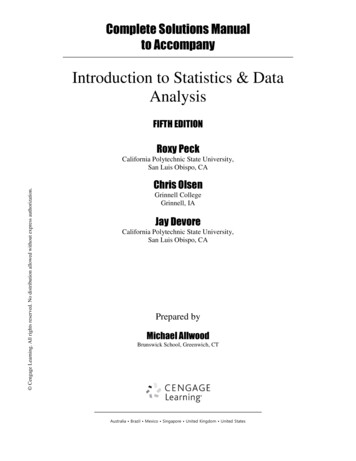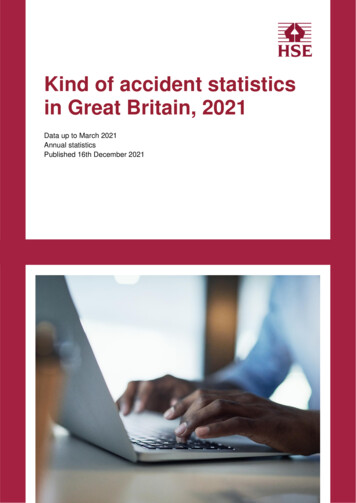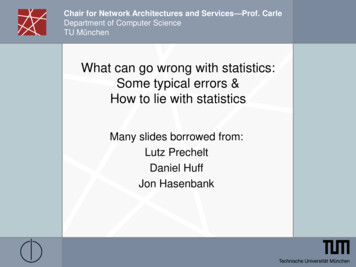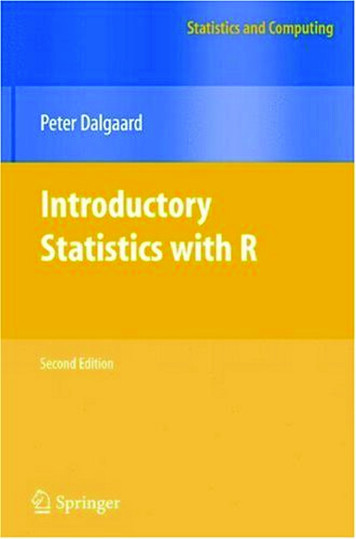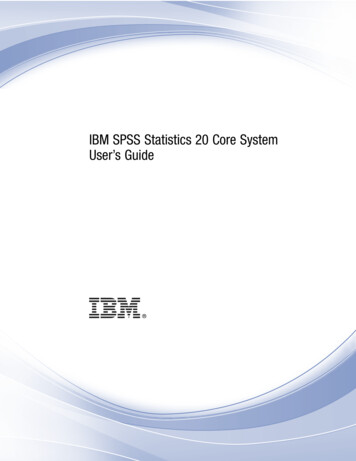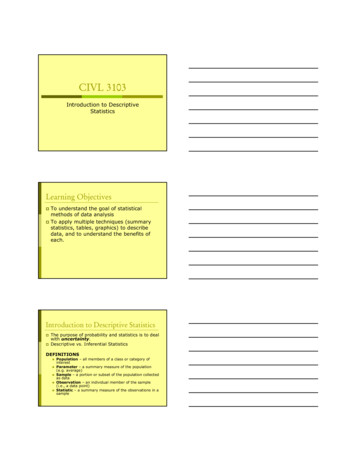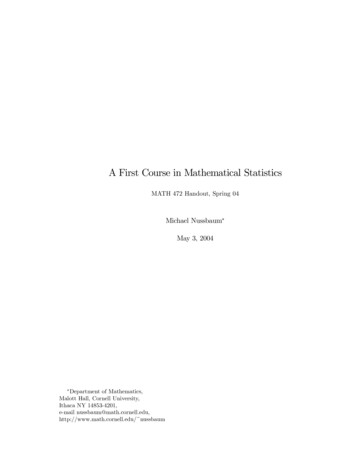
Transcription
ORNL/TM-2020/1566Background Data and Statistics on LowIncome Energy Use and Burden for theWeatherization Assistance Program:Update for Fiscal Year 2020Erin RoseBeth HawkinsJune 2020Approved for public release.Distribution is unlimited.
DOCUMENT AVAILABILITYReports produced after January 1, 1996, are generally available free via US Department of Energy(DOE) SciTech Connect.Website www.osti.govReports produced before January 1, 1996, may be purchased by members of the public from thefollowing source:National Technical Information Service5285 Port Royal RoadSpringfield, VA 22161Telephone 703-605-6000 (1-800-553-6847)TDD 703-487-4639Fax 703-605-6900E-mail info@ntis.govWebsite http://classic.ntis.gov/Reports are available to DOE employees, DOE contractors, Energy Technology Data Exchangerepresentatives, and International Nuclear Information System representatives from the followingsource:Office of Scientific and Technical InformationPO Box 62Oak Ridge, TN 37831Telephone 865-576-8401Fax 865-576-5728E-mail reports@osti.govWebsite http://www.osti.gov/contact.htmlThis report was prepared as an account of work sponsored by anagency of the United States Government. Neither the United StatesGovernment nor any agency thereof, nor any of their employees, makesany warranty, express or implied, or assumes any legal liability orresponsibility for the accuracy, completeness, or usefulness of anyinformation, apparatus, product, or process disclosed, or represents thatits use would not infringe privately owned rights. Reference herein toany specific commercial product, process, or service by trade name,trademark, manufacturer, or otherwise, does not necessarily constituteor imply its endorsement, recommendation, or favoring by the UnitedStates Government or any agency thereof. The views and opinions ofauthors expressed herein do not necessarily state or reflect those of theUnited States Government or any agency thereof.
ORNL/TM-2020/1566Energy and Transportation Science DivisionBACKGROUND DATA AND STATISTICS ON LOW-INCOME ENERGY USE ANDBURDEN FOR THE WEATHERIZATION ASSISTANCE PROGRAM: UPDATE FORFISCAL YEAR 2020Erin RoseBeth HawkinsJune 2020Prepared byOAK RIDGE NATIONAL LABORATORYOak Ridge, TN 37831-6283managed byUT-BATTELLE, LLCfor theUS DEPARTMENT OF ENERGYunder contract DE-AC05-00OR22725
CONTENTSCONTENTS. iiLIST OF FIGURES . iiiLIST OF TABLES . iiiABBREVIATIONS AND ACRONYMS . ivACKNOWLEDGMENTS . vEXECUTIVE SUMMARY . vi1. INTRODUCTION . 12. ENERGY-RELATED CHARACTERISTICS OF LOW-INCOME HOUSEHOLDS. 32.1 DEFINING THE LOW-INCOME POPULATION . 32.2 HOUSEHOLD INCOME . 32.3 HOUSING AND HOUSEHOLD CHARACTERISTICS . 42.4 FUEL TYPES . 53. ENERGY CHARACTERISTICS . 73.1 ENERGY CONSUMPTION . 73.2 ENERGY EXPENDITURE. 83.3 DISTRIBUTION OF WAP-ELIGIBLE HOUSEHOLD ENERGY EXPENDITURES . 103.4 ENERGY BURDEN . 124. OTHER KEY CONSIDERATIONS FROM THE WAP EVALUATIONS . 185. CONCLUSIONS AND RECOMMENDATIONS . 196. REFERENCES. 20APPENDIX A. METHODOLOGY . A-1ii
LIST OF FIGURESFigure 1. Comparison of housing type between WAP national evaluation and 2009 RECS. . 4Figure 2. Primary heating fuel for WAP eligible households. . 5Figure 3. US census regions and divisions. . 6Figure 4. Comparison of fuel type between WAP national evaluation and 2009 RECS. . 6Figure 5. Estimated energy expenditures for FY 2020 by primary heating fuel. . 8Figure 6. Primary heating fuel for FY 2020 by housing type. . 9Figure 7. Estimated energy expenditures for FY 2020 by housing type. 9Figure 8. Expected energy expenditures for FY 2020 by census region for the WAP-eligiblepopulation. . 10Figure 9. US climate regions. 11Figure 10. Expected energy expenditures for FY 2020 by climate region for the WAP-eligiblepopulation. . 11Figure 11. Distribution of annual energy expenditures for the WAP-eligible population. . 12Figure 12. Mean energy burden by poverty status. . 13Figure 13. Distribution of annual energy expenditures for the WAP-eligible population. . 13Figure 14. Energy burden for FY 2020 by poverty status. . 14Figure 15. Energy burden for FY 2020 by census region. . 15Figure 16. Energy burden for FY 2020 by census division. . 15Figure 17. Mean energy burden for FY 2020 by climate region. . 16Figure 18. Mean energy burden for FY 2020 by main heating fuel . 16Figure 19. Mean energy burden for FY 2020 by housing type. . 17LIST OF TABLESTable 1. Occupant survey findings: reduced energy burden after weatherization . 18iii
ABBREVIATIONS AND RECSSPSSSTEOWAPWICWIPOUS Bureau of Labor StatisticsCode of Federal RegulationsConsumer Price IndexUS Department of EnergyOffice of Energy Efficiency and Renewable EnergyEnergy Information Administrationfiscal yearUS Department of Housing and Urban Developmentliquefied petroleum gasthousand British thermal unitsmillion British thermal unitsOak Ridge National Laboratoryprogram yearResidential Energy Consumption SurveyStatistical Package for the Social SciencesShort-Term Energy OutlookWeatherization Assistance ProgramWomen, Infants, and ChildrenWeatherization and Intergovernmental Programs Officeiv
ACKNOWLEDGMENTSThis research was supported by the US Department of Energy (DOE) Office of Energy Efficiency andRenewable Energy (EERE) Weatherization and Intergovernmental Programs Office (WIPO). The authorswould like to thank the many people who contributed their time to the review of this report, includingMark Ternes with Oak Ridge National Laboratory (ORNL), Derek Schroeder with DOE WIPO, andBruce Tonn with Three3, Inc. The authors would also like to acknowledge the original author, JoelEisenberg, whose work was adapted for this project.v
EXECUTIVE SUMMARYThis report provides updated estimates of the energy consumptions, energy expenditures, and energyburdens of the population eligible to be served through the US Department of Energy (DOE)Weatherization Assistance Program (WAP) and by proxy, those clients actually served by the program.WAP provides weatherization services to income-eligible households and is the largest single nationalresidential energy efficiency program operating within the United States. Estimating these energycharacteristics for the WAP-eligible population helps to establish the need for WAP and provides data onthe program’s effectiveness in meeting its statutory mandate to reduce total residential energyexpenditures while prioritizing assistance to targeted households, including high-residential energy usersand households with high energy burdens. 1 These estimates also help to characterize the WAP-eligiblepopulation’s energy burden, and they provide insight into the potential for reductions in burden as a resultof energy savings achieved through WAP.This report updates the analyses previously performed by Eisenberg (2010, 2014) and provides furtherreasonable, transparent estimates of energy usage, expenditures, and burden across the WAP-eligiblepopulation. These estimates, especially those for energy burden, are stratified by household characteristics(i.e., poverty status, housing type, equipment, and fuel types), climate region, and geographic location.For the purposes of this analysis, WAP-eligible households are identified as those living at or below200% of US federal poverty guidelines 2 based on household income and size. The term energy burden isdefined herein as the percentage of household income spent on home energy expenditures (e.g., heatingand cooling, appliances, lighting).Eisenberg’s approach integrates two products from the DOE Energy Information Administration (EIA):the Residential Energy Consumption Survey (RECS) 3 for 2009 and the Short-Term Energy Outlook(STEO) for October or November from various years. RECS is an occasional survey of US householdsdating back to 1978 that provides detailed data on self-reported housing and energy characteristics, selfreported demographics, and energy consumption and expenditures verified through billing data. Althoughthe 2015 RECS is the most recent completed data collection, the 2015 RECS was not used to generateestimates of energy characteristics for FY 2020 because households could not be grouped by povertystatus using the 2015 RECS. The 2015 RECS used wider income bands compared to the narrower incomebands used in the 2009 RECS. 4 Without being able to determine which households would qualify forWAP, the 2015 RECS was not useable for this effort. The 2009 RECS was deemed to supply the mostuseful data for identifying WAP income-eligible households and to provide more extensive, more robustenergy consumption and billing data. The 2009 RECS database includes records on 12,083 individualhouseholds. The second EIA data resource used is the STEO monthly estimate of projected energy pricesfor the 18-month period immediately ahead, beyond October or November of a given year.To produce estimates of energy expenditures and burdens for the WAP-eligible population for fiscal year(FY) 2020 (October 2019 through September 2020), analysts used Eisenberg’s model (2010, 2014;Appendix A) that first normalized energy consumptions based on collected billing data (2009 RECS) totypical weather conditions using heating and cooling degree days. To account for important changes sincethe 2009 RECS was administered, modifications were made to adjust energy expenditures for changes infuel costs, and multipliers were added to adjust for increases in income between 2009 and 2020. FuelUnder the authority of Title 42 of the US Code, Chapter 81, Subchapter III, Part A, 6861; Code of Federal Regulation 10 CFRPart 440; 65 FR 77217, Dec. 8, 2000, as amended at 71 FR 35778, June 22, 2006.22019 Poverty Guidelines US States; Retrieved from the US Department of Health and Human US EIA RECS; Retrieved from 009/4It is anticipated that the 2020 RECS administered by EIA will revert to narrow income bands, allowing for better classificationof household poverty status necessary for identifying WAP-eligible households.1vi
price adjustments were made to Eisenberg’s model using STEO fuel price projections published inOctober 2019 for the upcoming 12 months (i.e., FY 2020).The mean income of the WAP-eligible population for FY 2020 using the adjusted 2009 RECS datasetwas estimated to be 22,243, with home energy costs estimated to be 1,782 annually. The mean energyburden for the WAP-eligible population across the United States for FY 2020 is estimated to be 13.9%compared to 3.0% for households living above the 200% poverty threshold.5 The mean energy burden forhouseholds living below the 100% federal poverty line was estimated to be 30.9%. When stratified byfuel type, WAP-eligible households heating with fuel oil experience the highest energy burden at 22.0%.Households living in the mixed-humid climate zone also experience a high energy burden at 16.7%. Thelowest energy burdens for WAP-eligible households are found in the West Census region of the UnitedStates and in the hot-dry / mixed-dry climate region, which both have an energy burden of 8.5%. TheMarine climate zone, which is also in the West region of the United States, has an energy burden of 9.5%.WAP’s most recent national evaluations collected and generated data pertinent to clients actually servedby WAP in 2008 and 2010. Select findings from the national WAP evaluations are included in this reportto complement the analyses of the 2009 RECS data and to allow energy characteristics to be comparedbetween the general population eligible for WAP as surveyed through the 2009 RECS and WAP programrecipients (i.e., to the population actually served by WAP).Conclusions derived from this study are that WAP continues to serve a population with an energy burden that is much greater than the rest ofthe county. The energy burden for the WAP-eligible population has remained steady at this high level overthe last decade. The energy burden for the WAP-eligible population for FY 2010 and FY 2014was previously estimated to be 14.2% and 16.3%, respectively. The energy burden estimated for the WAP-eligible population should be representative ofhouseholds weatherized by WAP. WAP clients with energy burdens that are higher than average could be targeted by focusing oneligible households or houses with select characteristics.It is recommended that the analysis presented in this report be updated in FY 2021 when the 2020 RECSdata become available. The 2020 RECS will provide current utility bills and incomes for the WAPeligible population that will not require significant if any adjustments as required in using the 2010 RECSfor this analysis.It is also recommended that energy burdens calculated for the WAP-eligible population from this orfuture analyses be compared to energy burden data for clients actually served by the program if and whensuch data are collected and become available. Such analysis will help identify differences between theWAP-eligible population and the population actually served by the program and if changes are desired inhow clients are selected or marketed.Mean income, home energy costs, and energy burdens were calculated using a 5% trimmed mean. A trimmed mean is a methodof averaging that excludes extreme values on the low and high ends of the sample distributions. It is less sensitive to outliers ordata points on the tails of a distribution that may unfairly affect the traditional mean.5vii
1.INTRODUCTIONThe US Department of Energy (DOE) Weatherization Assistance Program (WAP) is the largest singlenational residential energy efficiency program operating within the United States. It was created byCongress in 1976 under Title IV of the Energy Conservation and Production Act. The purpose and scopeof the program as currently stated in US Code of Federal Regulations (CFR) 10 CFR 440.1 is to:.increase the energy efficiency of dwellings owned or occupied by low-income persons[ ], reduce their total residential expenditures, and improve their health and safety,especially low-income persons who are particularly vulnerable such as the elderly,persons with disabilities, families with children, high residential energy users, andhouseholds with high energy burden. 6Estimating the energy consumptions, energy expenditures, and energy burdens of the eligible populationserved through WAP and for the clients actually served by the program helps to characterize the eligiblepopulation and those being served, measure the need for the program, and establish the program’seffectiveness in meeting its statuary mandate to reduce expenditures while prioritizing assistance tohouseholds with high energy consumptions and high energy burdens. Understanding these characteristicsalso provides insight into the potential for energy burden reduction through energy savings as a result ofWAP.The term energy burden is defined herein as the percentage of household income spent on home energyexpenditures (e.g., heating and cooling, appliances, lighting) and thus is a simple function of householdincome and energy expenditures. Energy expenditures, income, and energy burden are all responsive to anumber of external forces, such as changes in economies ranging from national to local, fluctuations infuel prices, and impacts of technological and energy efficiency improvements.This report provides estimates of these energy characteristics (i.e., energy consumption, energyexpenditure, and energy burden) for Fiscal Year (FY) 2020 for households that are income-eligible toreceive services through WAP, and by proxy, those clients who are actually served by the program. In sodoing, this report updates estimates developed for FY 2010 and FY 2014 by Joel Eisenberg (2010, 2014).Until data resources are available to directly measure these energy characteristics for the householdsserved by WAP, they must be estimated using external data sources representing the general eligiblepopulation.The analysis presented in this report is based on data provided in the Energy Information Administration(EIA) Residential Energy Consumption Survey (RECS) of 2009. RECS provides detailed data on housingcharacteristics, energy characteristics, and demographics that are self-reported, as well as energyconsumption and expenditures verified through billing data. The 2009 RECS used for this analysis is notthe most recent survey in this series. Although the 2015 RECS is the most recent completed datacollection, the 2015 RECS was not used to generate estimates of energy characteristics for FY 2020because households could not be grouped by poverty status using the 2015 RECS. The 2015 RECS usedwider income bands compared to the narrower income bands used in the 2009 RECS.7 Without being ableto determine which households would qualify for WAP, the 2015 RECS was not useable for this effort.The 2009 RECS was deemed to supply the most useful data for identifying WAP income-eligibleSee footnote 1.It is anticipated that the 2020 RECS administered by EIA will revert to narrow income bands, allowing for better classificationof household poverty status.671
households and to provide more extensive, more robust energy consumption and billing data. The 2009RECS database contains records on 12,083 individual households.To produce energy expenditure and burden estimates for the WAP eligible population for FY 2020, the2009 RECS energy consumption data derived from collected billing data were normalized to typicalweather conditions using heating and cooling degree days. Adjustments were made in the 2009 RECSdata to account for changes in fuel costs that occurred between 2009 and 2020 using EIA’s Short-TermEnergy Outlook (STEO) fuel price projections by census region and division in various years. Householdincome was adjusted for inflation from 2009 to 2020 using the US Bureau of Labor Statistics (BLS)inflation indices by census region.Section 2 of this report defines the WAP-eligible population and the population served by WAP.Household and housing characteristics are also provided to better understand these populations. Section 3provides estimates of energy consumption, expenditures, and burden for FY 2020 based on the 2009RECS subsample eligible for WAP. Energy burden estimates are then presented with consideration topoverty levels, census region and division, climate zones, and heating and cooling costs. Section 4provides other key findings generated from the most recent WAP evaluations that are useful forunderstanding the impacts of energy burden on households served through WAP and its potentialbenefits. Conclusions and recommendations are presented in Section 5.2
2.ENERGY-RELATED CHARACTERISTICS OF LOW-INCOME HOUSEHOLDSSince the 2009 RECS was released, national evaluations have produced and published statistics thatdirectly characterize the clients actually served by WAP for program years (PYs) 2008 and 2010. 8 Selectevaluation findings are used herein to compare statistics for the general WAP income-eligible populationfound in the 2009 RECS data to the WAP population actually served. Establishing comparisons betweenthe two data sources is important for determining if the RECS population is generally reflective ofhouseholds served through WAP and can therefore be used, as a proxy, to reflect the energy burden ofclients served through WAP.2.1DEFINING THE LOW-INCOME POPULATIONWAP Grantees (i.e., all 50 US states, the District of Columbia, American Indian Tribes, and the five USterritories 9) and Subgrantees (i.e., agencies that deliver WAP to eligible households within establishedservice areas) are required to determine income eligibility for households that apply for services. WAPcurrently defines eligibility as household income at or below 200% of the federal poverty guidelines,although WAP Grantees are permitted to use other agreed-upon federal income eligibility guidance todetermine eligibility for services. For example, eligibility for many programs at the US Department ofHousing and Urban Development (HUD) is defined as household income at or below 80% of the localarea median income.For the purposes of this analysis, the general approach for determining WAP eligibility (i.e., being at orbelow 200% of the poverty guidelines) was used for grouping and classifying participating 2009 RECShouseholds as WAP eligible.2.2HOUSEHOLD INCOMEThe mean income of the WAP-eligible population as provided in the 2009 RECS and adjusted forinflation for FY 2020 is estimated to be 22,243 compared to 83,684 for households not eligible forWAP. 10 Overall, the average income for WAP clients served by the program in PY 2010 was less thanthat estimated for the income-eligible population. Based on household-level information gathered throughthe national WAP evaluations, WAP households living in single-family homes reported higher annualincomes than households living either in small or large multifamily buildings (i.e., buildings with 2-4units and 5 or more units, respectively). 11 The median household income reported by WAP clientsresiding in single-family homes in PY 2010, adjusted for inflation for FY 2020, is estimated to be 18,179 compared to 12,100 reported by those living in multifamily buildings. Ten percent of thesesingle-family WAP clients had an income of 8,387 or less, and more than 10% had incomes of 39,254or more (Blasnik et al. 2015; Carroll et al. 2015). 12The full collection of national WAP evaluation reports can be found at: https://weatherization.ornl.gov/reports/One important consideration for this analysis is that the 2009 RECS data do not include information for households living in thefive United States territories.10Mean incomes were calculated using a 5% trimmed mean. A trimmed mean is a method of averaging that excludes extremevalues on the low and high ends of the sample distribution. It is less sensitive to outliers or data points on the tails of adistribution that may unfairly affect the traditional mean.11Both the 2009 RECS and the WAP national evaluations defined small multifamily buildings as those with 2–4 housing unitsand large multifamily buildings as those with 5 housing units. This contrasts with other definitions, such as the definition usedby WAP energy audits, which defines small, multifamily buildings to be 2–24 units and large multifamily buildings to be 25 units.12For comparison purposes, WAP recipients’ median income reported in PY 2010 has been adjusted using the national BLSConsumer Price Index (CPI) inflation multiplier (1.165) and are presented in 2020 dollars.893
2.3HOUSING AND HOUSEHOLD CHARACTERISTICSBased upon the 2009 RECS, there were approximately 39.5 million households in the United States thatwere federally eligible for WAP out of 113.6 million households nationwide; within this population, 16.9million households were categorized as having income at or below the poverty level (Eisenberg 2014).In his original analyses, Eisenberg (2010, 2014) used the 2009 RECS to characterize the WAP-eligiblepopulation in terms of household demographics, census region, and housing types. Eisenberg reportedthat nearly 60% of households contained at least one paid worker, approximately 28% received foodassistance, 33% received retirement income, and just under half owned their own homes. The homeownership statistic varies from data gathered through the national evaluations of WAP, which found that87% of WAP program recipients were homeowners. Evaluation findings also revealed that only about athird were employed for wages, with an equal percent reporting a retirement status (Carroll et al. 2014a).According to the 2009 RECS, the WAP-eligible population is generally distributed across the UnitedStates in proportions similar to the distribution of the population not eligible for WAP, withapproximately 16% in the Northeast, 23% in the Midwest, 41% in the South, and 20% in the West(Eisenberg 2014). A somewhat higher percentage of households not eligible for WAP, about 4% more,are in the Northeast, and about 6% fewer are in the South (Eisenberg 2014).On balance, housing types did not largely diverge between the WAP-served population (from the nationalevaluations) and the WAP-eligible population (from RECS data). Figure 1 presents comparisons betweenWAP units weatherized during PY 2008 (Carroll et al. 2014b) and the WAP-eligible population identifiedin the 2009 RECS. 13 More households weatherized in PY 2008 lived in manufactured homes 14 comparedto the WAP-eligible population in 2009, and fewer households lived in small and large multifamilybuildings.WAP units weatherized (PY 08)5%18%18%59%WAP eligible population - RECS mall multifamilyLarge multifamilyFigure 1. Comparison of housing type between WAP national evaluation and 2009 RECS.13In the left chart of Figure 1, “WAP units weatherized,” the single-family site-built housing category combines single-familydetached and single-family attached housing, which is separated in the 2009 RECS chart.14The term manufactured housing is interchangeable with the term mobile home, which is used in the 2009 RECS for thishousing type.4
2.4FUEL TYPESThe WAP income-eligible consumers have profiles similar to other consumers in terms of the primaryheating fuel type they use, with a slightly higher proportion than the general population using propane 15for this purpose (Eisenberg 2014). As shown in Figure 2, the largest single heating fuel type is naturalgas, with approximately 43% of WAP-eligible households using this fuel. Electricity is used as theprimary source for heating by 39% of WAP-eligible households. Home heating oil and propane are usedby about 5% of these households.Percentage of HouseholdsPrimary heating fuel by region for WAP-eligible householdsat or below 200% ral GasElectricityPropaneFuel OilWoodKeroseneNAAcross .7%36.3%3.5%0.4%3.4%0.2%14.4%Figure 2. Primary heating fuel for WAP eligible households. 16The distribution of heating fuel type varies substantially by census region (Figure 3). Most of the homeheating oil is used by WAP-eligible households in the Northeast, whereas electricity is the dominantheating source in the South, and natural gas predominates in the Midwest (Eisenberg 2014). Distributionof heating fuel type has important implications for the average level of residential expenditures andenergy burdens in the various parts of the country, as home heating oil and propane pr
Appendix A) that first normalized energy consumptions based on collected billing data (2009 RECS) to typical weather conditions using heating and cooling degree days. To account for important changes since the 2009 RECS was administered, modifications were made to adjust energy expenditures for changes in
